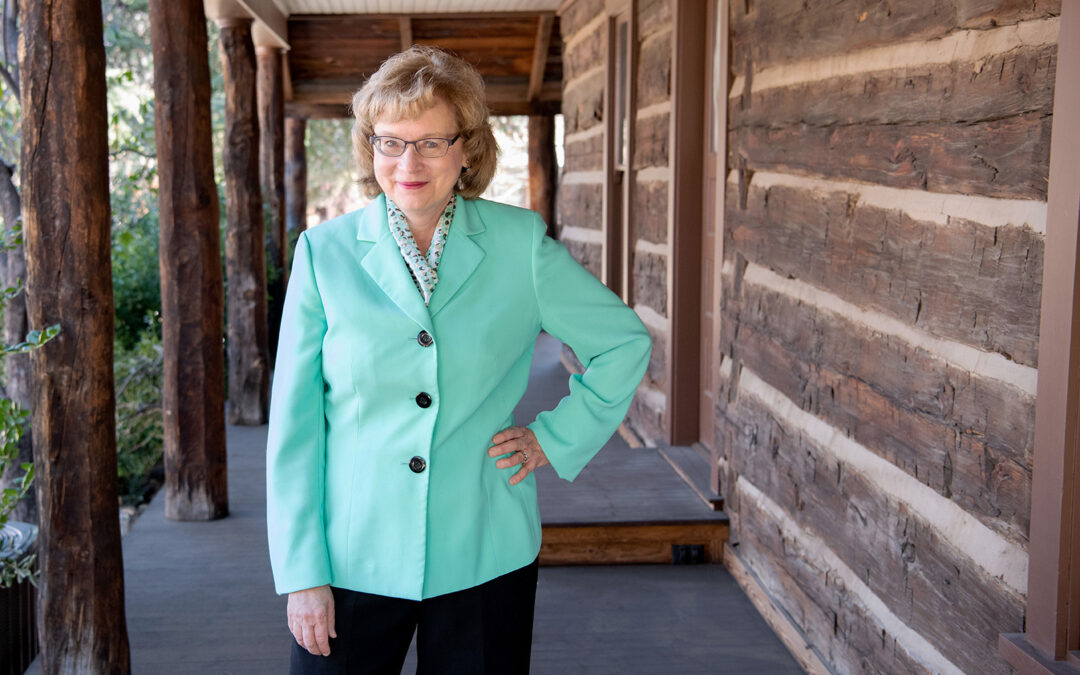As Sharlot Hall Museum Approaches its Centennial, New Director Hopes to Cultivate a Deeper Connection with Locals and Visitors Alike
It’s a daunting task to move cross-country mid-winter, amid a global pandemic, to take on the leadership of a heritage site and cultural destination considered the “Crown Jewel” of Arizona museums.
For Dr. Lisa Hayes, the new director of the Sharlot Hall Museum, it’s an opportunity to connect people to a sense of place—the spot’s heritage site, historic buildings, and landscape—created by a woman of vision, Sharlot Mabridth Hall.
“For 10 years my landscape was a colonial living history farm and national park in Maryland,” she explained, “at an organization created by a Congresswoman more than 60 years ago to preserve the view from George Washington’s Mount Vernon directly across the Potomac River.
“Now my landscape is a distinctive four-acre campus in downtown Prescott,” she says, “at a museum created more than 90 years ago by another extraordinary woman, Miss Sharlot Hall.”
Lisa said she feels “truly honored to be the new director at the Museum, the centerpiece of history and heritage in the Central Highlands of Arizona. It’s a dream come true!”
She added that as the museum staff moves forward toward celebrating its centennial, it seems fitting that leadership should pass to a woman after decades of leadership from such men as Fred Veil, John Langellier, Richard Sims, and Mack Harris.
“The Museum’s namesake, Miss Sharlot, was a woman ahead of her time,” Lisa said. “A writer, poet, ranch woman, political lobbyist and historian at the turn of the 19th century.”
“By bringing a similar variety of entrepreneurial and creative skills to the museum, I hope to have the kind of impact in the 21st century that she had at the beginning of the 1900s.”
With a doctorate in American Studies, Lisa brings a love of history and a passion for education to the museum, with a particular interest in living history programming.
“One of the biggest competitors for museums is the wealth of entertainment individuals and families can access from the comfort of their own home,” she said. “Living history programs at the Museum provide an entertaining way to get out… to discover our history and heritage. With community engagement and dynamic educational programming, I believe we can attract a wider audience while providing an engaging experience that helps cultivate repeat visitation.”
She said that as we look to the future and life “after the pandemic,” history museums have an important role in helping people understand current events through the lens of history.
“To do that, museums must evolve in how they tell their community’s stories and find ways of engaging their community as partners in sharing these stories,” she explained. “This means change… and change is always challenging. It’s not for the faint of heart.”
Arriving in Prescott in mid-December, Lisa spent her first 100 days as museum director by focusing on program development with a vision toward a post-pandemic time when visitors, families, and friends are excited to re-explore their community and environs.
“I’m enjoying the challenge of bringing together the diverse expertise and wide range of talents among the Museum’s corps of staff and volunteers,” she said, adding, “We’re working together to develop program enhancements that bring about additional community engagement and appreciation for the heritage and history embodied in the historic buildings and exhibits at Sharlot Hall Museum. Museums thrive when they are active participants in the community.”
Previously, Lisa worked as CEO of the Accokeek Foundation, stewards of the National Colonial Farm, a living history museum, and 200-acre Piscataway Park, part of the national park system in Maryland.
While there, she guided the organization through major changes, orchestrated the development of innovative new programs, and managed a public/private partnership, much like that of the Sharlot Hall Museum.
“I’m excited and optimistic for our future,” she said. The more participatory and engaging we make our programs, the more we can make this museum an even more popular and frequented destination for visitors and community members alike.”

